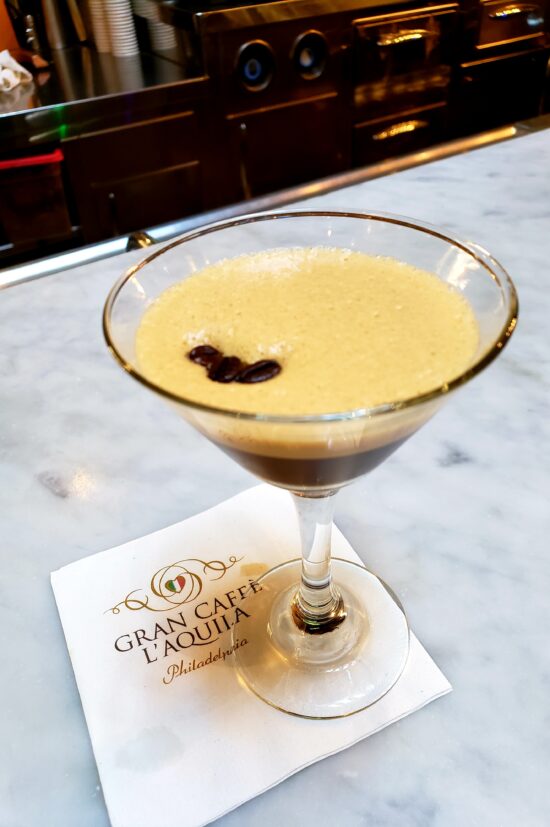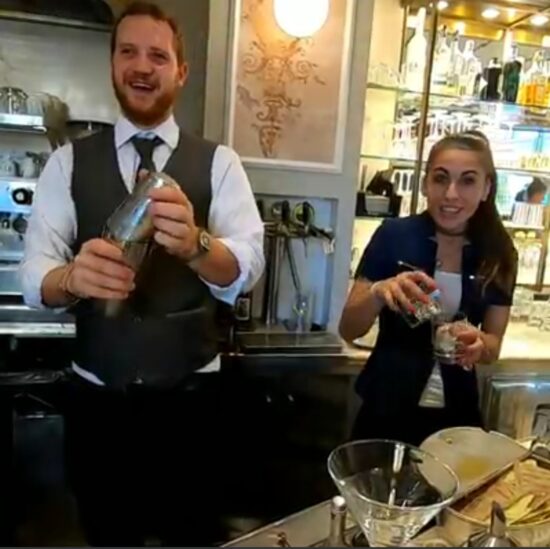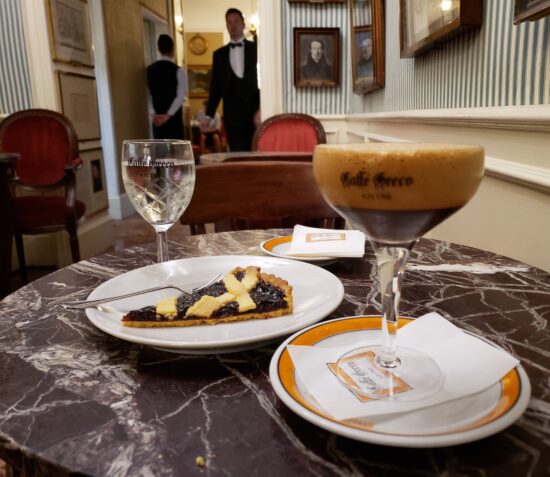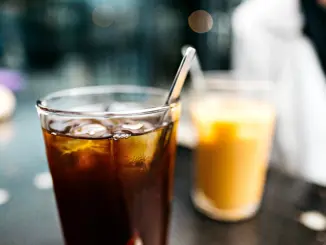
We take a look at the history and popularity of the shakerato.
BY EDDIE P. GOMEZ
SPECIAL TO BARISTA MAGAZINE
Photos by Eddie Gomez
Elusive, elegant, and definitely one of the most refreshing cold drinks available during warm weather, the caffé shakerato is an espresso-based drink that is typically served up foamy in a martini glass. It’s a popular drink in Italy throughout the summer months. A well-made shakerato delivers an intense but balanced flavor punch, even though it is made of only three ingredients: espresso, sugar, and ice. They’re all combined in a cocktail tumbler and shaken vigorously until a good amount of foam is created. The foam separates from the espresso base after the liquid has been strained into a chilled glass. Many people unfortunately underestimate the deliciousness of a shakerato and how easy it is to make one, so they are not often found on specialty-coffee menus.

The Backstory
Discussing the shakerato reminds me of something that happened when I studied abroad in Italy. One of our classes on the history of Italian food and culture spent several weeks studying Italian coffee culture, and a central question arose about the practice of sipping espresso while standing at the bar. There were so many stories about where the custom began that most of us ended up utterly confused. Finally, one day the professor threw his hands up in frustration and said, “I’ve researched that question for 30 years. Nobody will ever know where it started, yet every little town from Milan to Calabria claims to have invented it. Just be glad we have a thriving coffee culture here for you to enjoy.”
Basically, the origin of the shakerato is also unknown, yet the name is taken from the English verb “shake.” There are, interestingly, more than a few people throughout Italy who claim to know the origins of the humble drink. Let’s just say that those claims make for good storytelling, but they do not necessarily give us an accurate sense of history in terms of the shakerato’s true beginnings. It’s a bit like the story about Kaldi and the dancing goats—we will never know if Kaldi ever existed or whether or not he ran into a herd of goats that were in the throes of a coffee-induced state of ecstasy.
What we do know about the history of iced coffees in Italy is that as early as the late 1700s, iced coffee was served in Salento, a tradition imported from Valencia where coffee was said to have been chilled with snow. We can also imagine that, in the coffee-producing regions around the world where snow and ice are naturally preserved throughout the seasons, coffee could have easily been chilled during hot summer months. After all, necessity and human curiosity have long resulted in great-tasting food as a result of a little experimenting.
The Positives
In an Italian coffeehouse, it is a cool thing to see bowtie-wearing baristas prepare a shakerato by vigorously shaking a cocktail tumbler filled with coffee in one direction and then another. Although it is not exactly the height of sophistication, it does come across as a small but meaningful performance, especially in the more elegant cafés. There is just something inherently captivating about the showmanship undertaken to fill, shake, and pour the contents of the tumbler into a glass, all in one seemingly flawless motion that concludes with the drink being passed across the bar with a seriousness that signals something spectacular has just happened.
I recently spoke with Federica, one of the managers at Sant’ Eustachio il Caffè in Rome, one of the city’s most popular coffee destinations, famous for its quality arabica beans and breathtakingly beautiful location in the shadows of the Pantheon. When asked about what makes the shakerato so popular in Italy, she responded: “It’s a refreshing drink for the long Italian summers and so much more fun to drink than a normal espresso.”

The Challenges
Preparing a shakerato is sometimes viewed as a disruption to the streamlined processes most baristas use in cafés across the United States. This, perhaps, is one of the top reasons the drink has never taken off in the U.S. Making a shakerato commands a barista’s full attention, much like a pourover does, so there isn’t time to do much else, even though the process is fun and easy. Also, making a shakerato blurs the line between bartender and barista, a crossover skillset that not all baristas are comfortable taking on, not to mention that it takes some amount of practice to get good at making one.
I believe cold brew and nitro cold brew are also somewhat to blame for the shakerato’s life on the margins. When cold brew burst onto the scene more than a decade ago, it was a new way to prepare coffee that tasted great and provided a nicely balanced drink, much like a shakerato does. People got really excited about it and soon it was everywhere on café menus. What little chance the shakerato stood of gaining traction in popularity evaporated, outshined by cold brew and all the other great drinks that followed in that category. Luckily, the beauty and timelessness of the shakerato endures, albeit on the margins, while it waits for the wider recognition that it has long deserved.
It’s possible to get super fancy when making shakeratos by adding liqueurs and other ingredients. In James Hoffmann’s YouTube video titled “Caffe Shakerato – Three Recipes,” he starts with a simple recipe but goes on to demonstrate two elaborate versions that are simply take-offs from the simplicity of the basic model. In another video, a person speaks of adding smoked salt and other high-profile ingredients, but for a lot of caffé shakerato fans, the simplest recipe is the most delicious. So, at the start of your shakerato-making adventures, stick to the basic version for this classic cold coffee drink.

A Classic Version of a Shakerato
Ingredients and equipment:
A cocktail tumbler
2 shots of espresso
10 grams of syrup at a 1:1 ratio of sugar to water (a debate rages here—traditionalists insist on using raw sugar; Frederica reacted strongly against using syrup when asked how shakeratos are sweetened at her shop)
Two drops of saline solution or the equivalent of .15 grams at a 20-to-1 ratio of water to salt (optional) – meant to “take the edge off the bitterness” and believed by some to aid in achieving a foamy head
10 medium-sized ice cubes – make sure that there is enough ice to cool down the espresso and enough pieces of it left over after cooling to create the necessary aeration when shaken
Combine the ingredients in the tumbler and shake for 20 to 30 seconds, or until a thick, foamy head is achieved, remembering that you are shaking to “chill and to create foam”
Strain into a chilled glass and enjoy.
ABOUT THE AUTHOR
Eddie P. Gomez (he/him) is a freelance writer based in Modesto, Calif. When he is not substitute teaching kindergarten classes, he wanders from city to city, perfecting the art of the food and coffee adventure.



